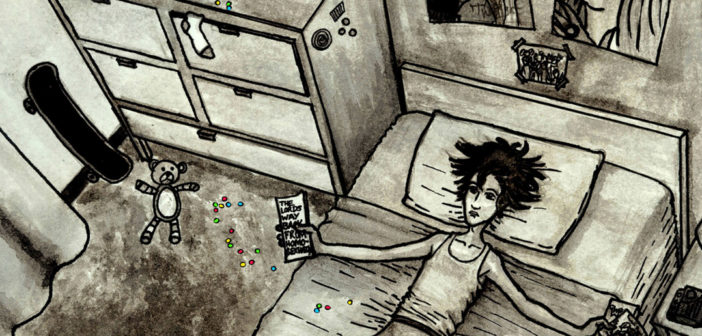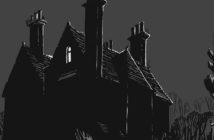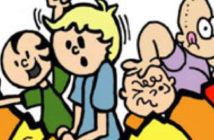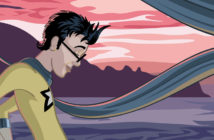Brian Andersen’s Friend of Dorothy is a comic book with a whole lot of heart. Yes, it’s yet another sojourn into the world of Oz, but no, it’s not tedious or predictable. Oz in this book is a tangible allegory: an allegory for being different, alone, and yearning for the opportunity to break free in search of excitement and meaning.
The book opens in black and white—an obvious and expected tribute to the original 1939 film released by MGM. We see the main character, Scott-John, lying on his bed in a depressed stupor. He’s holding a picture of his lost love, though lost to what we don’t know. There it a bottle of spilled pills; each capsule is garishly colored in opposition to the monotone environment. It’s a typical sob scenario.
Thankfully, the sobbing doesn’t last long. Before Scott-John fades into oblivion, he’s visited by Gorlindo, the shirtless Good Witch of Oz. He’s a handsome and cheeky fellow who delivers the news to Scott-John that he’s destined to save Oz from impending doom. To aid him on his journey, he’s granted boons of power: an axe, a pair of gloves, a heart-shaped pendent, and a pair of ruby go-go boots, which Scott-John sports smashingly I must say.
But Gorlindo doesn’t have a lot of time to mentor the plucky hero, as he’s quickly attacked by a small vanguard of Scrows, scarecrow-like henchmen distorted by dark powers. Who sent them and why is a mystery, but Scott-John doesn’t waste time picking up the axe he was given and making quick work of them. It’s a good thing, too, as a single scratch from a Scrow will drain away the life from the unfortunate recipient.
Though Gorlindo quickly splits, another guide appears to help our protagonist: the talking dog, Dodo. He is the descendent of the much-loved Toto, though I don’t remember the latter having the sharp tongue of the former. It’s Dodo’s task to guide Scott-John to Oz and help him complete his journey of rescuing the magical land from evil.
In creator/writer Andersen’s foreword, he says that his inspiration for the book comes from the gay slang “FoD-er,” which I assume is the same as the book’s namesake, “Friend of Dorothy.” He also addresses the assumed fact that many in the gay community have a great love for The Wizard of Oz and its subsequent spin-offs. Why this is, I don’t know. I’ve known many gay people over the years, and only two were ever able to recite lines from Wicked. I assume it’s a form of diva worship, but doesn’t that only address a certain segment of the gay community? What about everyone else?
But I am being unfair by posing the argument in this forum. Friend of Dorothy is the story and reflection of Andersen’s though process and personality—not what I think it should be. He’s able to smoothly guide the plot as it unfolds: he manages his panels with restraint, and his writing is controlled with lively dialogue sprinkled all around.
The illustrations of artist Centeno are simple but effective; this book is a small jaunt of the imagination, and Centeno captures the atmosphere well. And as a compliment, Falecia Woods’ use of flamboyant and garish colors harkens back to when the original Wizard of Oz was released with its Technicolor visuals.
Friend of Dorothy works. It works as a light-hearted fantasy comic, a tribute to L. Frank Baum’s everlasting legacy with a modern socio-cultural twist, and as a peek into the life of an outsider simply trying to find his place in the world. Let the adventure begin.
This comic book review originally appeared on Broken Frontier.




